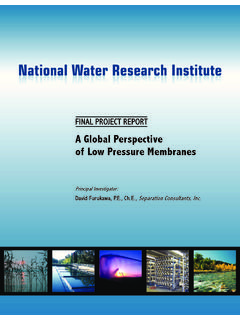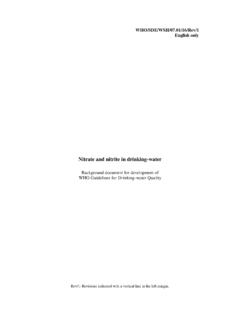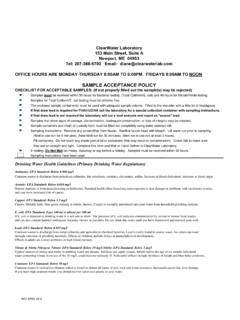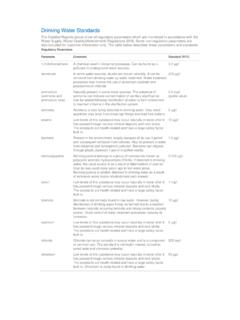Transcription of What does TOC mean to my drinking water …
1 April Nabors, EngineerBirmingham water Works Board Barron, Principal Engineer, BWWBJeff Cochran, Engineer, BWWBWhat does TOC mean to my drinking water treatment plant?OutlineLearning ObjectivesIntroduction: EPA Regulations & BWWBM ethodsPrevious FindingsResultsConclusionsLearning Objectives RevisitedFuture of this studyLearning ObjectivesWhat is TOC and how does it relate to DBPs?Key EPA the basic process for treatment optimization which coagulant is the best at TOC removal. Introduction: drinking water RegulationsTotal Organic Carbon (TOC) is defined as a measure of the total amount of organic matter that is present in the water . In the drinking water industry, it is used as a measurement of water quality and given strict guidelines for removal through the Stage 1 Table -Required % Removal of TOC Source to (mg/L) to (mg/L) > (mg/L) suggests that TOChas a direct effect on DBPsthat are form during the treatment process as well as in the distribution TOC Increase chlorine demand High DBPsIntroduction: drinking water RegulationsStage2 Disinfectants/DisinfectionByproductsRule (DBPR)willbeimplementedin2012furthertigh teningregulationsonDBPs,specificallytota ltrihalomethane(TTHM)andhaloaceticacid(H AA) : BWWBL ocation: South-eastern United StatesPopulation: Serve an estimated 600,000 customersMaximum Treatment Capacity: 190 MGDI ntroduction: BWWB The BWWB is located in Birmingham, Alabama.
2 Birmingham residents enjoy a humid, subtropical climate with average summer highs in the 90 s and average winter lows in the mid 30 s. Rainfall is distributed somewhat evenly throughout the year with October being the historically driest of BWWB Treatment PlantsFour Conventional Surface water Treatment Plants: Shades Mountain Filter Plant Western Filter Plant Putnam Filter Plant H. Y. Carson Filter PlantTwo Lakes used for source water : Inland Lake Lake PurdyShades Mountain Filter PlantOldest and Largest PlantMax Flow Rate of 80 MGD46 Sand & Anthracite FiltersCarson Filter PlantNewest of the four plants -built in 1972 Max Flow Rate of 26 MGD16 Sand & Anthracite FiltersCurrent operations utilize alum, hydrated lime, coagulant and filter ionic polymers, potassium permanganate, chlorine gas and sand/anthracite filters. Pilot PlantoMobileoSCADAoMax rate of 14,000 gpd (10gpm)oFull analytical lab for analysisoTwoidentical treatment trainsPilot PlantRapid mix and sedimentation basin FiltersPilot Plant Treatment trains include: raw water tanks rapid mix chambers flocculation basins sedimentation basin three dual media filters finished water tank The twin design enables researchers to test two separate treatment methods concurrently.
3 Pilot Plant The PP contains all other online and bench-top equipment used for analysis found at the full scale plant. turbidimeters pH and temperature probes streaming current monitors particle counters conductivity meters TOC analyzers spectrophotometersMethodsImportant water quality parameters include: oTotal and Dissolved Metals (Manganese, Iron, Copper)oChlorate, Chlorite, Nitrate, Nitrite, Sulfate, SulfiteoTOCoAlkalinityoTurbidityopHoTemp eraturePrevious Findings: SMFPIn 2008 and Spring of 2009, the Pilot Plant was used to perform an extensive evaluation of the current treatment process at from this study suggested that a simple change in the coagulant would be an effective way to optimize full scale operations by increasing TOC removal and thereby decreasing regulated DBP values. Alum to Ferric TOC Removal DBP valuesResults: CFPA fter many numerous failed trial runs, an optimum configuration and dosefor ferric was determined.
4 Lime addition to raw water No pre-oxidant needed Ferric to rapid mix Filter aid to filtersChlorine and pH adjustment post filtrationConclusionsOperators can effectively use TOC as an indicator for making key process control decisions such as chemical type and long as there is sufficient alkalinity in the source water , ferric sulfate is superior over aluminum sulfate for TOC removal. At both treatment plants, ferric sulfate has the ability to not only meet but far exceed the Stage 2 DBP Objectives What is TOC and how does it relate to DBPs? Key EPA regulations. Introduce the basic process for treatment optimization studies. Determine which coagulant is the best at TOC removal. Thank you!April ?









